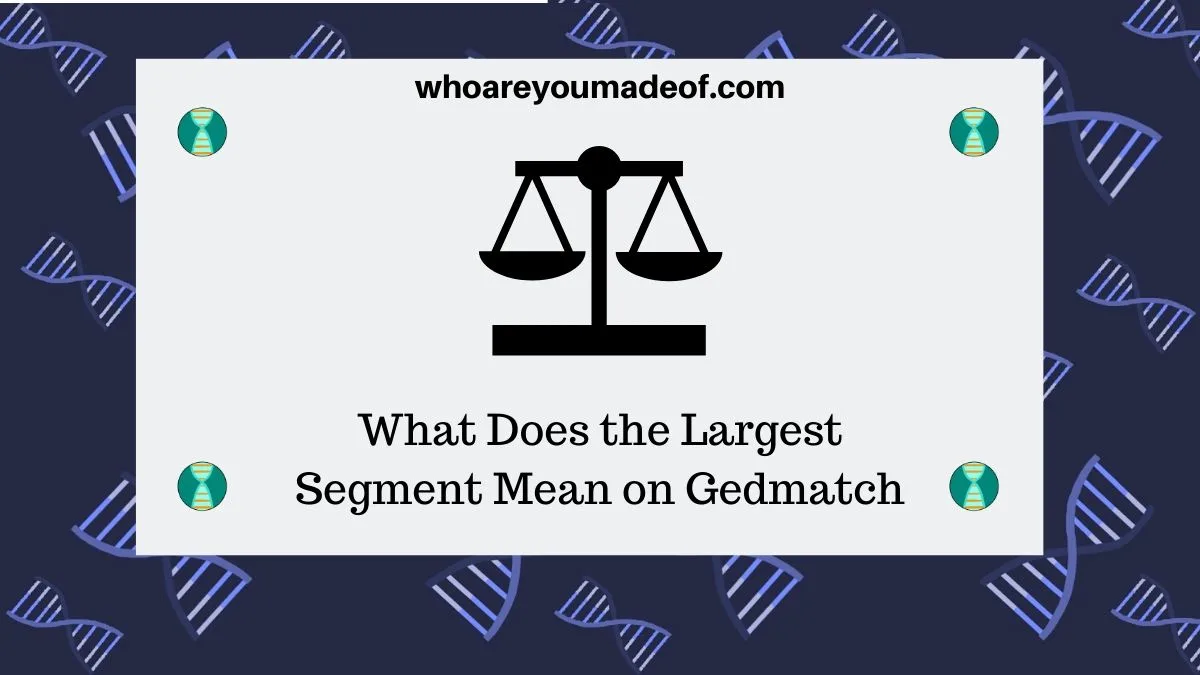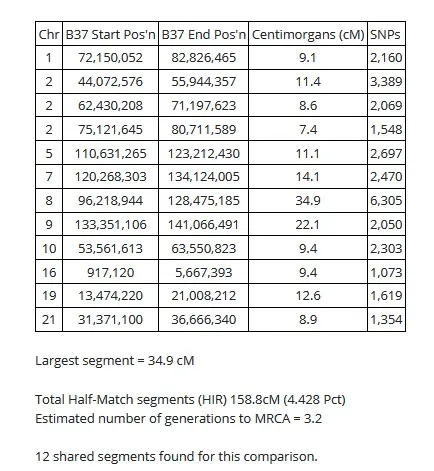If you have used Gedmatch, you need to know what the largest segment means. In this post, you will learn exactly what it is and how to understand how to use this information.

The most common place to find largest segment information on Gedmatch is by using the One-to-One autosomal comparison tool. This helpful tool can help us examine in more detail the DNA that we share with our relative.
When you run the tool, you see the largest segment information towards the very bottom of the results, where it says "Largest Segment" with a number and "cM" written after it. It will look something like the image below:

The image above is from using the One-to-One tool, which is essentially a chromosome browser, to compare my DNA with that of my grandmother. It shows that the largest segment that I share with my grandmother is 122.9 centimorgans in length. This is a long DNA segment, and you'll learn why size matters further on in the article.
cM stands for "centimorgans", a unit of measurement used to describe genetic distance. We generally use the One-to-One tool on Gedmatch to figure out how much total DNA we share with our matches, measured in centimorgans (cMs).
What does largest segment mean on Gedmatch?
The largest segment on Gedmatch is the size of the largest shared DNA segment that you share with your DNA match. The number that you see next to "largest segment" or in the largest segment column is the genetic length of this largest segment, measured in cMs.
For example, let's take a look at the following comparison between two individuals who are 2nd-3rd cousins and most likely related in more than one way:

They share twelve DNA segments larger than 7 centimorgans, ranging in size from 7.4 - 34.9 cMs. Even though they share lots of other segments, the largest shared segment is 34.9 cMs in length.
The difference between largest segment and total shared cMs
The total number of shared DNA is calculated by measuring the length of all of the shared DNA segments longer than the threshold, which is typically 7 cMs. The largest segment is the longest shared DNA segment among all shared segments.
In other words, we could share lots of DNA segments with a match, but one of them is longer than the others. In the case of sharing only one segment with a match, the largest segment will match the total number of shared centimorgans.
In the example that I showed you from the two people who share twelve DNA segments, we can see that the total number of shared DNA is 158.8 centimorgans.
We can compare this to the size of the largest segment of the total, with is 34.9 cMs.
Why is the size of the largest segment on Gedmatch important?
The size of the largest segment on Gedmatch is very important. This information can help you determine approximately how far back your most recent common ancestor might be.
How does knowing the size of the largest segment help us?
First, we must understand a bit about how DNA is passed down through the generations.
When we inherit DNA from our parents, their two copies of each chromosome go through a process called "recombination" to create brand-new chromosomes for us.
The segments that we inherit from our parents, therefore, are typically very long. For example, I share 17 segments with my dad that are longer than 100 cMs.
When we have children, our chromosomes go through the same recombination process. Our two copies of each chromosome are recombined to make one new chromosome for our children.
Some of the DNA segments that we inherited from our parents will get passed down to our children just like they are (i.e. "intact"), others will get passed down in pieces or "broken up", and others won't get passed down to our children at all.
Over the next few generations, the DNA segments that our parents passed down to us will continue to go through this fairly random recombination process. Our descendants will inherit DNA segments from our parents that are much smaller (shorter) than the ones that we inherited.
As a basic rule of thumb, the larger the segment, the more recent the common ancestor.
Segments larger than 100 cMs typically indicate a recent common ancestor within a couple of generations. Segments smaller than 30 cMs could have been inherited from a common ancestor as far back as eight generations, and occasionally further.
In other words, we can use the size of the largest estimate to roughly estimate how far back the common ancestor might be.
How can largest segment on Gedmatch help figure out relation to DNA match
Once you know how big the largest shared DNA segment is, you can use this to help figure out how you may be related to your DNA match. The first step is to figure out approximately how far back in your family tree your common ancestor could be.
Once you have determined this, you can then compare family tree information with your DNA match in order to spot your common ancestor(s).
You can also use the People who match both or 1 of 2 kits tool to find matches that you share in common, which could provide additional clues about your relationship.
Conclusion
I hope that this post has helped you understand what the largest segment means on Gedmatch, and how you can use this valuable information to determine how you may be related to your DNA match.
If you have any questions about something that you read in this post, or if you would like to ask a question about a largest segment that you share with a match on Gedmatch, I would love to hear from you in the discussion below.
Thanks for stopping by today!

Richard
Monday 12th of June 2023
Several kits I work with have single segment matches that are over 50 cM. But this is is the only DNA thy share. So instead of a 3c 1 x r or even 3 c or 1/2 2C 1 x removed, could this mean the match is further back?
Paula Beeson Burns
Monday 10th of October 2022
OK if I'm trying to figure out who's who but they have my nephew down as my first cousin but he is actually my half sisters son but they said we are cousin how is that possible And have someone who they said is my 3rd3rd cousin but we have very high segments I'm lost haha hlp
Jill
Saturday 5th of March 2022
Unknown person in my Ancestry DNA matches. 1641 cM shared across 32 segments. Unweighted shared DNA is also 1641. 24% DNA match. 178 cM longest segment match. Only related to my dad’s side.
Impossibilities: grandma, granddaughter, niece, double cousin.
Mercedes
Thursday 17th of March 2022
Hi Jill, This is definitely a very close relative. The following calculator can provide relationship possibilities, and then you can exclude those that you know are not possible: https://dnapainter.com/tools/sharedcmv4 Best of luck to you, Mercedes